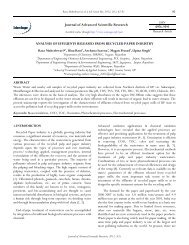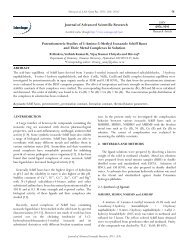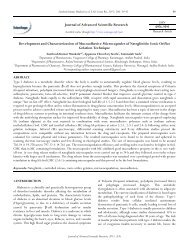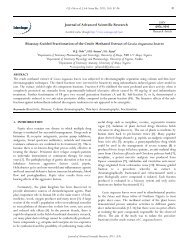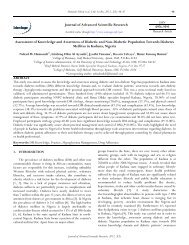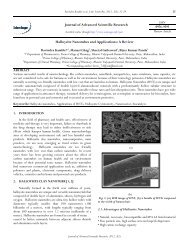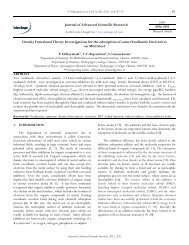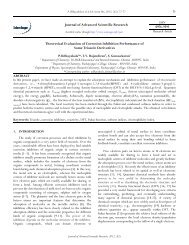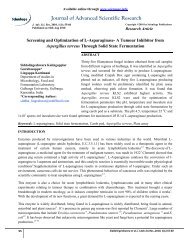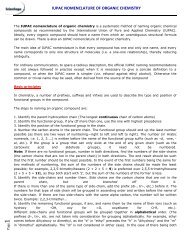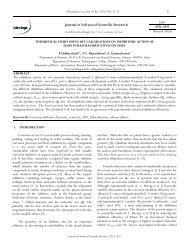Formulation and Evaluation of Glimepiride Solid ... - Sciensage.info
Formulation and Evaluation of Glimepiride Solid ... - Sciensage.info
Formulation and Evaluation of Glimepiride Solid ... - Sciensage.info
You also want an ePaper? Increase the reach of your titles
YUMPU automatically turns print PDFs into web optimized ePapers that Google loves.
Wagh V.T. et al, J Adv Sci Res, 2012, 3(4): 36-41 36<br />
Journal <strong>of</strong> Advanced Scientific Research<br />
Available online through http://www.sciensage.<strong>info</strong>/jasr<br />
ISSN<br />
0976-9595<br />
Research Article<br />
<strong>Formulation</strong> <strong>and</strong> <strong>Evaluation</strong> <strong>of</strong> <strong>Glimepiride</strong> <strong>Solid</strong> Dispersion Tablets for Their Solubility Enhancement<br />
Wagh V. T.*, Jagtap V.A., Shaikh T.J., N<strong>and</strong>edkar S. Y.<br />
DCS’s A.R.A. College <strong>of</strong> Pharmacy, Nagaon, Dhule.424005 MH. India<br />
*Corresponding author: wagh.vinod517@gmail.com<br />
ABSTRACT<br />
<strong>Glimepiride</strong> (GMP) is poorly water soluble drug, so solubility is the main constraint for its oral bioavailability. The objective <strong>of</strong> the<br />
research project is to enhance <strong>of</strong> the solubility <strong>of</strong> <strong>Glimepiride</strong> by using solid dispersion technique. The polymers used were<br />
Poloxamer 188 <strong>and</strong> Poloxamer 407 <strong>and</strong> solid dispersions were prepared by kneading method. The solubility study was carried out<br />
to study the effect <strong>of</strong> polymers on solubility <strong>of</strong> <strong>Glimepiride</strong>. The prepared solid dispersions were characterized by In-vitro solubility<br />
Study, %Drug content; Fourier transforms spectroscopy (FTIR), In vitro drug dissolution to identify the physicochemical<br />
interaction between drug <strong>and</strong> excipients. The dissolution studies <strong>of</strong> solid dispersion were performed by using USP II apparatus. The<br />
solid dispersion prepared with Poloxamer 188 showed better drug release as compared to solid dispersion prepared with Poloxamer<br />
407. The drug release pr<strong>of</strong>ile <strong>of</strong> F5 batch with Poloxamer 188 was 98.20±0.19 in 60 min. <strong>and</strong> drug release pr<strong>of</strong>ile <strong>of</strong> F11 batch<br />
with Poloxamer 407 was 97.39±0.18 in 60 min. in pH 7.4. The results <strong>of</strong> dissolution studies <strong>and</strong> stability study the kneading<br />
method prepared solid dispersion by using Poloxamer 188 (Batch F5) was selected for tablet formulation. Tablet formulations were<br />
prepared by direct compression technique <strong>and</strong> developed tablet formulations were evaluated for various pharmaceutical<br />
characteristics viz. hardness, % friability, weight variation, drug content, in-vitro dissolution pr<strong>of</strong>iles. Thus Results showed that the<br />
solid dispersion technique by using poloxamer successfully used for enhancing the solubility <strong>of</strong> <strong>Glimepiride</strong>.<br />
Keywords: <strong>Glimepiride</strong>, poloxamer 188, poloxamer 407, solid dispersions, solid dispersion tablets.<br />
1. INTRODUCTION<br />
More than 40 percent <strong>of</strong> the drug coming from highthroughput<br />
screening are poorly soluble in water compounds<br />
with poor Solubility are increasingly posing challenges in the<br />
development <strong>of</strong> new drugs, since a large number <strong>of</strong> drugs<br />
coming directly from synthesis or from high throughput<br />
screening have a very poor solubility. It is well known that<br />
drug efficacy can be severely limited by poor aqueous<br />
solubility, leading to low dissolution rate <strong>and</strong> thus results in<br />
low absorption in the gastrointestinal tract after oral<br />
administration hence comprising oral bioavaibility. The ability<br />
to increase aqueous solubility is thus a valuable aid to increase<br />
the efficacy for certain drugs [1].<br />
The Biopharmaceutical Classification system divides drugs<br />
into four classes depending on in vitro <strong>and</strong> in vivo permeability<br />
data [2]. Four classes <strong>of</strong> compound can be distinguished: I (high<br />
solubility, high permeability), II (low solubility, high<br />
permeability), III (high solubility, low permeability) <strong>and</strong> IV<br />
(low solubility <strong>and</strong> low permeability). Class I compounds are<br />
typical examples for waiving bioequivalence studies. In the<br />
selection process, new chemical compound with low aqueous<br />
solubility <strong>and</strong> low permeability are preferably filtered out since<br />
they might pose problems during pharmaceutical development.<br />
For class II drugs dissolution /solubility <strong>and</strong> for Class III drug<br />
permeability limits the oral drug absorption. It is obvious that<br />
class II drugs the low ability to dissolve is a more important<br />
limitation to their overall rate <strong>and</strong> extent <strong>of</strong> absorption than<br />
their ability to permeate through the intestinal epithelia. There<br />
are several pharmaceutical strategies available to improve the<br />
aqueous solubility <strong>of</strong> poorly soluble drugs: solid dispersion,<br />
solubilization using surfactant, the use <strong>of</strong> co-solvent, reduction<br />
<strong>of</strong> particle size, hydrotropy <strong>and</strong> the use <strong>of</strong> aqueous soluble<br />
derivatives or salts [3].Among all technique solid dispersion<br />
(SD), is the most efficient technique from the dispersion in<br />
carrier more specially define the system has the dispersion <strong>of</strong><br />
the one or more active ingredient in an inert matrix at solid<br />
state perform by melting method, solvent evaporation method<br />
<strong>and</strong> melting solvent [4]. Since long, many investigators have<br />
studied SDs <strong>of</strong> poorly water‐soluble drugs with various<br />
pharmacologically inert carriers to increase the dissolution <strong>and</strong><br />
oral absorption <strong>of</strong> poorly water soluble drugs, however, only a<br />
few system are useful commercially [5].<br />
Poloxamer have been recently widely used as wetting <strong>and</strong><br />
solubilizing agents as well as surface adsorption excipients.<br />
They have been employed to enhance the solubility, dissolution<br />
<strong>and</strong> bioavailability <strong>of</strong> many hydrophobic drugs using various<br />
techniques, for some drugs, the improvement in solubility<br />
using Poloxamer was higher compared to the other meltable<br />
Journal <strong>of</strong> Advanced Scientific Research, 2012, 3(4)
polymers such as PEGs <strong>and</strong> complex forming agents such as<br />
cyclodextrin. In the present study, Poloxamer was thus<br />
empirically selected as a hydrophilic carrier for its excellent<br />
surfactant properties <strong>and</strong> oral safety [6].<br />
The main possibilities for improving dissolution according<br />
to analysis are to increase the surface area available for<br />
dissolution rate by decreasing the particle size <strong>of</strong> the solid<br />
compound <strong>and</strong> or by optimizing the wetting characteristics <strong>of</strong><br />
the compound surface, to decrease the boundary layer<br />
thickness, to ensure sink condition for dissolution <strong>and</strong> last but<br />
definitely not least, to improve the apparent solubility <strong>of</strong> drug<br />
under physiologically relevant condition [7].<br />
<strong>Solid</strong> dispersion(SD) technique are developing to modify<br />
the physicochemical <strong>and</strong> biopharmaceutical properties <strong>of</strong> drug,<br />
for above mentioned techniques BCS Class II drugs are selected<br />
because low solubility <strong>and</strong> high permeability like antidiabetic<br />
drugs. Antidiabetic drugs to be absorbed must be present in the<br />
form <strong>of</strong> an aqueous solution at the site <strong>of</strong> absorption for their<br />
hypoglycemic activity so solubility enhancement technique s<br />
are more essential for drugs like <strong>Glimepiride</strong> (GMP) 3-ethyl-4-<br />
methyl-N-{2-[4-({[(4methylcyclohexyl) carbamoyl]amino}<br />
sulfonyl) phenyl] ethyl, is thiozolidinedioneantidiabetic agent<br />
that depends on the presence <strong>of</strong> insulin for its mechanism <strong>of</strong><br />
action lowering blood glucose appears to be dependent on<br />
stimulating the release <strong>of</strong> insulin from functioning pancreatic<br />
beta cell.<br />
<strong>Glimepiride</strong> (GMP) is classified under class II according to<br />
biopharmaceutical classification system [8].The drug shows<br />
low, pH dependent solubility. In aqueous media, glimepiride<br />
exhibits very poor solubility at 37˚C (7, solubility <strong>of</strong> drug is slightly increased. This poor<br />
solubility may cause poor dissolution <strong>and</strong> unpredicted<br />
bioavailability. It is practically insoluble in water <strong>and</strong> other<br />
aqueous media. However, the drawback <strong>of</strong> this potentially<br />
useful hypoglycemic agent is that it is highly hydrophobic <strong>and</strong><br />
practically insoluble in water [9].<br />
The presented research work thus deals with the techniques<br />
<strong>of</strong> enhancement <strong>of</strong> solubility as well as dissolution <strong>and</strong><br />
bioavaibility <strong>of</strong> poorly aqueous soluble drugs like <strong>Glimepiride</strong>.<br />
2. MATERIAL AND METHODS<br />
GMP was obtained from Cipala Pharmaceuticals Ltd. Mumbai<br />
as a gift sample; PXM 188 was obtained from Alembic<br />
pharmaceutical Pvt. Ltd. Badodara, <strong>and</strong> PXM 407 Alembic<br />
pharmaceutical Pvt. Ltd. Badodara. Polyvinyl Pyrollidone,<br />
Lactose, Sodium Starch glycolate <strong>and</strong> Magnesium stearate were<br />
obtained from Loba Chemie Pvt. Ltd, Mumbai, India.<br />
2.1. Preparation <strong>of</strong> physical mixture [10]<br />
A physical mixture <strong>of</strong> <strong>Glimepiride</strong> with Poloxamer 188 or<br />
Wagh V.T. et al, J Adv Sci Res, 2012, 3(4): 36-41 37<br />
Poloxamer 407 in 1:1 ratio was prepared by thoroughly mixing<br />
the accurately weighed quantity <strong>of</strong> drug <strong>and</strong> carrier in by using<br />
glass mortar <strong>and</strong> pestle for 5 min. This mixture was then<br />
subsequently passed through mesh no. 40 <strong>and</strong> stored in a<br />
dessicator for 48 h.<br />
2.2. Preparation <strong>of</strong> <strong>Solid</strong> Dispersion [10]<br />
The Kneading method (KM) was used for the preparation<br />
<strong>of</strong> solid dispersion. Six different drugs: Carrier ratios (1:1, 1:2,<br />
1:3, 1:4, 1:5, <strong>and</strong> 1:6.) were used. F1 to F6 corresponds to<br />
preparations containing Poloxamer 188 <strong>and</strong> F7 to F12<br />
correspond to preparations containing Poloxamer 407.<br />
<strong>Glimepiride</strong> <strong>and</strong> Poloxamer 188 or 407 were weighed<br />
according to these weighed ratios. <strong>Glimepiride</strong> <strong>and</strong> Poloxamer<br />
were triturated using a small volume <strong>of</strong> isopropyl alcohol to<br />
give a thick paste, which was kneaded for 30 minutes <strong>and</strong> then<br />
dried at 40˚C in an oven. The dried mass was then pulverized,<br />
passed through mesh no. 30, stored in a vacuum desiccator (48<br />
h) <strong>and</strong> passed through sieve no. 60 before packaging in an<br />
airtight container.<br />
2.3. Determination <strong>of</strong> drug content [11]<br />
The drug content was calculated by dissolving solid<br />
dispersion equivalent to 2 mg <strong>of</strong> <strong>Glimepiride</strong> was transferred<br />
to 100 ml volumetric flask <strong>and</strong> dissolved in minimum amount<br />
<strong>of</strong> methanol; <strong>and</strong> the volume was made up to 100 ml with<br />
phosphate buffer (pH 7.4) <strong>and</strong> then solution was filter through<br />
0.45-µm membrane filter paper <strong>and</strong> assayed for drug content<br />
using UV double beam spectrophotometer at 228 nm.<br />
2.4. Solubility Determination [12]<br />
Phase solubility was performed as described by Higuchi<br />
<strong>and</strong> Connors. Excess amount <strong>of</strong> solid dispersion were added to<br />
25 ml phosphate buffer (pH 7.4) taken in a stoppered conical<br />
flasks, <strong>and</strong> mixture were shaken for 24 hrs in a rotary flask<br />
shaker. After shaking to achieve attain equilibrium, 2 ml<br />
aliquots were withdrawn at 1 hr intervals <strong>and</strong> filtered through<br />
whatman filter paper no 40. The filtrate was<br />
analyzedspectrophotometrically at 228 nm. Shaking was<br />
continued until three consecutive reading were the same.<br />
2.5. Fourier transforms infra-red spectroscopy [13]<br />
FT-IR spectra were recorded on the sample prepared in<br />
KBr disks (2 mg sample in 200 mg KBr) using Shimadzu<br />
Fourier Transform Infra-Red spectrophotometer. The scanning<br />
range was 500-4000/cm with a resolution <strong>of</strong> 4/cm.<br />
2.6. In vitro drug release [14]<br />
Accurately weighed preparations equivalent to 2 mg <strong>of</strong><br />
<strong>Glimepiride</strong> were added to 900 ml <strong>of</strong> dissolution media (7.4<br />
phosphate buffer) contained in USP dissolution apparatus II <strong>and</strong><br />
Journal <strong>of</strong> Advanced Scientific Research, 2012, 3(4)
stirred at a speed <strong>of</strong> 50 rpm at 37±0.5˚C. Five milliliter<br />
aliquots were withdrawn at 10, 20, 30, 40, 50 60 minute <strong>and</strong><br />
replaced by 5 ml <strong>of</strong> fresh dissolution media (37˚C). The<br />
collected samples were analyzed after suitable dilution at 228<br />
nm using UV-visible spectrophotometer against the blank. The<br />
dissolution <strong>of</strong> pure <strong>Glimepiride</strong> was done similarly.<br />
2.7. <strong>Formulation</strong> <strong>and</strong> evaluation <strong>of</strong> <strong>Glimepiride</strong> solid<br />
dispersions tablets<br />
2.7.1. <strong>Evaluation</strong> <strong>of</strong> blends [15]<br />
The quality <strong>of</strong> tablet, once formulated by rule, is<br />
generally dictated by the quality <strong>of</strong> physicochemical properties<br />
<strong>of</strong> blends. There are many formulations <strong>and</strong> process variables<br />
involved in mixing step <strong>and</strong> all these can affect the<br />
characteristics <strong>of</strong> blend produced. The various characteristics <strong>of</strong><br />
blends tested are bulk density, tapped density, compressibility<br />
index, Hausner ratio, <strong>and</strong> angle <strong>of</strong> repose.<br />
2.7.2. Preparation <strong>of</strong> Tablets <strong>of</strong> <strong>Solid</strong> Dispersions<br />
Tablets containing equivalent to 2 mg <strong>of</strong> <strong>Glimepiride</strong><br />
solid dispersion (F5) were prepared by direct compression.<br />
The blend was compressed on a 16 station rotary machine<br />
using round shaped, concave punches. The composition <strong>of</strong><br />
tablet is given in Table No. 1.<br />
Table No.1: Composition <strong>of</strong> Tablet <strong>Formulation</strong><br />
Ingredients <strong>Formulation</strong> (mg)<br />
<strong>Solid</strong> dispersion 12<br />
Polyvinyl Pyrollidone 08<br />
Lactose 110<br />
Sodium Starch glycolate 18<br />
Magnesium stearate 02<br />
2.7.3. <strong>Evaluation</strong> <strong>of</strong> glimepiride solid dispersion Tablets<br />
[16]<br />
All prepared tablets were evaluated for drug content,<br />
friability, hardness <strong>and</strong> weight variation <strong>and</strong> in vitro drug<br />
dissolution. Friability was determined using Roche friabilator.<br />
Hardness was measured using Pfizer hardness tester.<br />
2.7.4. Content Uniformity <strong>of</strong> Tablets<br />
Ten tablets were weighed <strong>and</strong> crushed in a small<br />
mortar. The fine powder equivalent to 2 mg <strong>of</strong> <strong>Glimepiride</strong><br />
was transferred to 100 ml volumetric flask containing 10 ml <strong>of</strong><br />
methanol <strong>and</strong> dissolved. The volume was made up to 100 ml<br />
with NaOH. The solution was filter through 0.45-µm<br />
membrane filter paper. One ml <strong>of</strong> this solution was diluted<br />
100 times <strong>and</strong> the absorbance was measured at 228 nm.<br />
Wagh V.T. et al, J Adv Sci Res, 2012, 3(4): 36-41 38<br />
2.7.5. In vitro drug dissolution<br />
<strong>Glimepiride</strong> formulated tablet were added to 900 ml <strong>of</strong><br />
dissolution media (pH 7.4 phosphate buffer) contained in USP<br />
dissolution apparatus II <strong>and</strong> stirred at a speed <strong>of</strong> 50 rpm at 37 ±<br />
0.5˚C. Five milliliter aliquots were withdrawn at 10, 20, 30,<br />
40, 50, 60 minute <strong>and</strong> replaced by 5 ml <strong>of</strong> fresh dissolution<br />
media (37˚C). The collected samples were analyzed after<br />
suitable dilution at 228 nm using UV-visible<br />
spectrophotometer against the blank. The dissolution <strong>of</strong> pure<br />
<strong>Glimepiride</strong> was done similarly.<br />
3. RESULTS AND DISCUSSION<br />
3.1. Drug content estimation<br />
The drug content <strong>of</strong> <strong>Glimepiride</strong> solid dispersion was<br />
found to be in range 97.59 to 99.82 <strong>and</strong> these values are within<br />
the acceptable range. Low values <strong>of</strong> st<strong>and</strong>ard deviation in<br />
respect <strong>of</strong> with respect to drug content, as given in Table No.<br />
2, indicating uniform drug distribution in all the solid<br />
dispersions.<br />
Table No. 2: <strong>Evaluation</strong> <strong>of</strong> % Drug content <strong>and</strong> solubility Study<br />
<strong>Formulation</strong><br />
Solubility<br />
%Drug content<br />
Code<br />
mg/ml<br />
Pure drug - 0.0074<br />
PM 1 98.95 0.013<br />
PM 2 91.92 0.011<br />
F1 98.24 0.126<br />
F2 97.59 0.167<br />
F3 97.96 0.212<br />
F4 98.67 0.235<br />
F5 99.82 0.345<br />
F6 99.26 0.320<br />
F7 97.62 0.074<br />
F8 97.90 0.125<br />
F9 97.92 0.202<br />
F10 98.33 0.282<br />
F11 99.63 0.324<br />
F12 98.82 0.314<br />
3.2. Solubility Studies<br />
The solubility pr<strong>of</strong>ile <strong>of</strong> <strong>Glimepiride</strong> was found to be<br />
0.0074mg/ml suggesting a strong need to enhance the<br />
solubility <strong>and</strong> dissolution <strong>of</strong> <strong>Glimepiride</strong>. Therefore, a solid<br />
dispersion technique using Poloxamer 188 <strong>and</strong> Poloxamer 407<br />
was employed for solubility <strong>and</strong> dissolution enhancement <strong>of</strong><br />
<strong>Glimepiride</strong> in the present investigation. The improvement in<br />
solubility was observed with for all solid dispersion, Increase in<br />
weight fraction <strong>of</strong> surface-active carrier resulted in an increase<br />
in the solubility <strong>of</strong> all dispersions. Maximum solubility<br />
enhancement was found in 1:5 ratio <strong>of</strong> <strong>Glimepiride</strong>:<br />
Journal <strong>of</strong> Advanced Scientific Research, 2012, 3(4)
Poloxamer 188 prepared by the kneading method.ie<br />
0.345mg/ml Enhancement in saturation solubility was found<br />
to be in order <strong>of</strong> Poloxamer 188>Poloxamer 407, Solubility<br />
study as given in Table No. 2.<br />
3.3. Fourier transforms infra-red spectroscopy <strong>of</strong> solid<br />
dispersion<br />
Wagh V.T. et al, J Adv Sci Res, 2012, 3(4): 36-41 39<br />
FT-IR spectra <strong>of</strong> <strong>Glimepiride</strong>, Poloxamer <strong>and</strong> <strong>Solid</strong><br />
dispersion (1:5). Characteristic peaks <strong>of</strong> <strong>Glimepiride</strong> at<br />
3344(3300-3500) (N-H), 2900(2850-3000) (C-H),<br />
2900(3300-2500) (O-H), 1427 <strong>and</strong> 1342(1350-1550) (N=O),<br />
1072(1220-1020) (C-N) <strong>and</strong> 1033(1000-1300) (C-O) were<br />
observed.<br />
Fig. 1: FT-IR <strong>of</strong> (a) <strong>Glimepiride</strong>; (b) Poloxamer 188; (c) Poloxamer 407; (d) Physical mixture <strong>of</strong> <strong>Glimepiride</strong> with PXM 188; (e)<br />
Physical mixture <strong>of</strong> <strong>Glimepiride</strong> with PXM 407; (f) <strong>Solid</strong> dispersion with PXM 188<br />
<strong>of</strong> Poloxamer up to a certain limit, <strong>and</strong> after that then it almost<br />
Due to similarities in molecular structure, <strong>of</strong> Poloxamer<br />
becomes constant. The dissolution <strong>of</strong> drug from solid<br />
188 <strong>and</strong> Poloxamer 407 showed similar absorption b<strong>and</strong>s, in<br />
dispersion was found to be faster than that from physical<br />
which characteristic peaks <strong>of</strong> OH stretching (3443/cm), CH<br />
mixtures <strong>and</strong> drug this may be due to the molecular <strong>and</strong><br />
stretching (2880/cm), C-H bending (1477/cm), C-H<br />
colloidal dispersion <strong>of</strong> drug in hydrophilic carrier matrix <strong>of</strong><br />
bending (1452/cm) respectively for Poloxamer-188 <strong>and</strong><br />
poloxamer.<br />
Poloxamer-407 <strong>and</strong> R-O stretching (1097/cm) were observed.<br />
All solid dispersion showed peaks <strong>of</strong> <strong>Glimepiride</strong> (pure) <strong>and</strong><br />
carriers. As the carrier concentration was increased, the<br />
intensities <strong>of</strong> carrier peaks also increased while with the<br />
decrease in the intensities <strong>of</strong> the drug peaks decreased. These<br />
results indicate that there is no chemical interaction between<br />
drug <strong>and</strong> carrier when formed as solid dispersion.<br />
3.4. In vitro drug dissolution studies<br />
The in vitro release pr<strong>of</strong>ile <strong>of</strong> <strong>Glimepiride</strong> from<br />
Poloxamer 188 <strong>and</strong> Poloxamer 407 solid dispersions (prepared<br />
by the kneading method) <strong>and</strong> physical mixture formulation are<br />
shown in fig. 2 <strong>and</strong> 3, <strong>and</strong> the graph for the comparison <strong>of</strong> the<br />
cumulative percent release is illustrated in figure no.4.<br />
According to observations, drug dissolution was increased<br />
gradually with increasing the concentration <strong>of</strong> both the grades<br />
Fig. 2: In vitro drug release <strong>of</strong> <strong>Glimepiride</strong> in pH 7.4 phosphate<br />
buffer from solid dispersion <strong>and</strong> physical mixtures <strong>of</strong> glimepirie<br />
- PXM 188 systems<br />
Journal <strong>of</strong> Advanced Scientific Research, 2012, 3(4)
Wagh V.T. et al, J Adv Sci Res, 2012, 3(4): 36-41 40<br />
3.5.2. Post Compression <strong>Evaluation</strong> <strong>of</strong> Marketed &<br />
Formulated Tablet<br />
The result <strong>of</strong> post compression evaluation <strong>of</strong> formulated<br />
tablet is given in Table no. 4.<br />
Fig. 3: In vitro drug release <strong>of</strong> <strong>Glimepiride</strong> in pH 7.4 phosphate<br />
buffer from solid dispersion <strong>and</strong> physical mixtures <strong>of</strong> glimepirie<br />
- PXM 188 systems<br />
Table no. 4: Post Compression <strong>Evaluation</strong> <strong>of</strong> Formulated<br />
Tablet<br />
Parameters<br />
Formulated Tablet<br />
Weight Uniformity (mg) 149.5 ± 0.45mg<br />
Content Uniformity (%) 99.23 %<br />
Friability (%) 0.5 ± 0.50<br />
Hardness (kg/cm 2 ) 3.9 ± 0.36kg/cm 2<br />
3.5.3. Dissolution Study <strong>of</strong> Tablet<br />
The formulated tablets were subjected to dissolution<br />
study in pH 7.4. Phosphate buffer is given in Figure no. 5<br />
Fig. 4: Comparative dissolution pr<strong>of</strong>iles <strong>of</strong> glimepiride in pH 7.4<br />
phosphate buffer from physical mixtures <strong>and</strong> solid dispersions<br />
prepared using PXM 188 <strong>and</strong> PXM 407<br />
3.5. <strong>Evaluation</strong> <strong>of</strong> the solid dispersion tablet dosage<br />
form<br />
3.5.1. Pre compression <strong>Evaluation</strong> <strong>of</strong> Drug- Excipients<br />
blend<br />
The results <strong>of</strong> pre compression evaluation <strong>of</strong> Drug-<br />
Excipients blend are given in Table no. 3. The value <strong>of</strong> angle <strong>of</strong><br />
repose was found to be below 30 which indicate good flow<br />
property. The bulk density <strong>and</strong> tapped density value was found<br />
to be less than one. Similarly the percentage compressibility<br />
(Carr’s Index) value for all batches was less than 16 % which<br />
also indicate that all batches <strong>of</strong> tablet blend have good flow<br />
property.<br />
Table no.3: <strong>Evaluation</strong> <strong>of</strong> <strong>Solid</strong> Dispersion Drug- Excipients<br />
blend<br />
Parameters <strong>Formulation</strong><br />
Angle <strong>of</strong> Repose (θ) 25.11<br />
Bulk Density (g/ml) 0.54<br />
Tapped Density (g/ml) 0.58<br />
% Compressibility 6.89<br />
Hausner Ratio 1.07<br />
Fig.5: In-vitro drug release pr<strong>of</strong>ile <strong>of</strong> formulated tablet<br />
When the mixture comes in contact with water, the<br />
polymer particles might have hydrated rapidly into polymeric<br />
solution, solubilizing the adjacent drug particles <strong>and</strong><br />
subsequently releasing the drug into the medium. Reason for<br />
improvement <strong>of</strong> <strong>Glimepiride</strong> release from solid dispersion with<br />
the increasing ratio <strong>of</strong> Poloxamer 188 <strong>and</strong> Poloxamer 407 is<br />
that at low concentrations, approximating those at which more<br />
conventional nonionic detergents from micelles, the<br />
poloxamer monomers are thought to form monomolecular<br />
micelles by through a change in configuration in solution. At<br />
higher concentration, these monomolecular micelles associate<br />
to form aggregates <strong>of</strong> varying size, which have the ability to<br />
solubilized drugs to a larger extent.<br />
In vitro drug release study indicates that Poloxamer 188<br />
shown better dissolution pr<strong>of</strong>ile than Poloxamer 407. This<br />
behavior could be explained further by the physico-chemical<br />
properties <strong>of</strong> these both poloxamers. Poloxamer 188 is<br />
composed <strong>of</strong> more hydrophilic polyethylene glycol polymers<br />
than Poloxamer 407. This composition leads to a higher<br />
Hydrophilic lipophilic balance (HLB) value <strong>and</strong> has a greater<br />
tendency to stabilize into the water than Poloxamer 407.<br />
Journal <strong>of</strong> Advanced Scientific Research, 2012, 3(4)
4. CONCLUSION<br />
The dissolution rate <strong>of</strong> <strong>Glimepiride</strong> was increased by solid<br />
dispersions prepared by the kneading technique by using<br />
poloxamers, without any physical <strong>and</strong> chemical interaction.<br />
<strong>Solid</strong> dispersions <strong>of</strong> Poloxamer 188 with Glimepride showed a<br />
enhancement in dissolution pr<strong>of</strong>ile as compare to physical<br />
mixtures as well as solid dispersion with poloxamer 407.<strong>and</strong><br />
whole in-vitro studies proved that Glimepride :Poloxamer<br />
188,1:5 ratio showed best results among all formulations.<strong>and</strong><br />
tablets prepared by that blend also showed better dissolution<br />
pr<strong>of</strong>ile <strong>and</strong> not affected by mechanical shocks while<br />
compression.<br />
5. REFERENCES<br />
1. Yalkowsky S., Technique <strong>of</strong> solubilization <strong>of</strong> Drugs. Drugs <strong>and</strong><br />
the pharmaceutical sciences vol.12 Marcher Dekker, New York,<br />
1981, 52-56.<br />
2. Amidon GL, Lennernas H, Shah VP. Pharm.Res, 1995; 12: 413-<br />
420.<br />
3. Chiou WL, Riegelman S., J pharm Sci, 1971; 60:1281-302.<br />
Wagh V.T. et al, J Adv Sci Res, 2012, 3(4): 36-41 41<br />
4. Craig DQ. Int J Pharm, 2002; 231:131-44.<br />
5. Ghebremeskel AN, Vemavarapu C, Lodaya M. Int J Pharm,<br />
2007; 328:119‐129.<br />
6. Chen Y, Zhang G, Neilly J, Marsh K, Mawhinney D, Sanzgiri Y.<br />
Int J Pharm, 2004; 286: 69‐80.<br />
7. Noyes AA, Whitney WR. J.Am.Chem.Soc, 1897; 19:930-34.<br />
8. Bobe K R. IJCP, 2011; 1:(02).<br />
9. Chawdhary KPR, Vijayasrinivas S., Indian Pharmacist, 2004; 2:<br />
7‐10.<br />
10. Chaudhary D, Kumar S. Asian journal <strong>of</strong> pharmaceutics, 2009:<br />
245-251.<br />
11. Rao MV, Shyam T. The Indian Pharmacist, 2008; 70:67-70.<br />
12. Higuchi T, Kristiansen H, J. Pharm. Sci, 1970; 59: 1601-1608.<br />
13. Chatwal GR, An<strong>and</strong> SK. Instrumental method <strong>of</strong> chemical<br />
analysis. Himalaya publishing house, New Delhi. 2004: 2.29-<br />
2.51.<br />
14. Farzana S, B<strong>and</strong>arkar, Ibrahim S, Khattab. Int.J. Pharm.Sci, 2011;<br />
3(2): 122-127.<br />
15. Aulton ME. Pharmaceutics: The science <strong>of</strong> dosage form design.<br />
2 nd edition, London: Churchill Livingstone; 2005.<br />
16. Lachman L, Liberman H A, Kanig J L; The Theory <strong>and</strong> Practice<br />
<strong>of</strong> Industrial Pharmacy, Verghese Publishing, Indian edition, 3rd<br />
edn.,1987;462-466.<br />
Journal <strong>of</strong> Advanced Scientific Research, 2012, 3(4)



